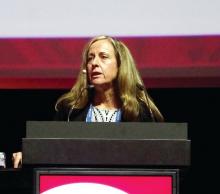LISBON – Patients with type 2 diabetes mellitus who also have moderate-to-severe chronic kidney disease (CKD) may be as effectively treated with the glucagonlike peptide–1 receptor agonist dulaglutide (Trulicity) as insulin glargine, the results of an international study showed.
Although comparable effects on glycemic control were seen, patients who received dulaglutide rather than insulin glargine in conjunction with prandial insulin lispro (Humalog) exhibited greater weight loss, had fewer episodes of hypoglycemia, and experienced beneficial effects on two important renal parameters.
There was “greater albuminuria reduction and markedly reduced eGFR [estimated glomerular filtration rate] decline” with dulaglutide than with insulin glargine, Katherine Tuttle, MD, reported at the annual meeting of the European Association for the Study of Diabetes.The adverse event profile of dulaglutide was typical of that seen with GLP-1 receptor antagonism, noted Dr. Tuttle, who is the executive director of Providence Medical Research Center, Providence Sacred Heart Medical Center in Spokane, Washington, and clinical professor of medicine in the nephrology division at the University of Washington in Seattle.
In Europe, the use of dulaglutide in patients with severely reduced kidney function is not currently recommended, and monitoring is required in the United States in those with gastrointestinal side effects.
AWARD-7 was a randomized, open-label parallel-arm study comparing once-weekly dulaglutide (0.75 mg or 1.5 mg) with insulin glargine plus prandial insulin lispro in 576 subjects who had T2DM and stage 3-4 chronic kidney disease. The aim of the trial was to show noninferiority of the dulaglutide regimen to the insulin glargine regimen.
The trial was open label because the dose of insulin glargine had to be regulated, Dr. Tuttle explained, but the dose of dulaglutide given was blinded. The dose of insulin glargine was targeted to fasting plasma glucose to achieve a value between 5.6 mmol/L and 8.3 mmol/L. The dose of insulin lispro was also adjusted to target preprandial plasma glucose between 6.7 mmol/L and 10.0 mmol/L.
Patients were included if they had a glycated hemoglobin (HbA1c) level of at least 7.5% but less than or equal to 10.5% (at least 57 but less than or equal to 91 mmol/mol) and an eGFR less than 60 but greater than or equal to 15 mL/min per 1.73 m2 at screening.
Approximately 45% of dulaglutide- and 52% of glargine-treated subjects were women; the average age of participants was 65 years, with an average duration of diabetes of around 18 years. The mean HbA1c level at study entry was 8.6% (70.5 mmol/mol), with around half of participants having a HbA1c above 8.5% (69.4 mmol/mol) at entry.
The majority of patients included had an eGFR of less than 45 mL/min per 1.73 m2, and about 30% of patients had stage 4 CKD (eGFR at least 15 but less than 30 mL/min per 1.73 m2), about 45% had macroalbuminuria, and a third or more had microalbuminuria.
The primary endpoint was change in HbA1c from baseline to week 26, and this was comparable for both dulaglutide (at around –1.1% to –1.2%) and insulin glargine (around –1.1%). The effects were maintained at 52 weeks, Dr. Tuttle said, adding that similar percentages (approximately 70% or more) of patients in the groups achieved a target HbA1c of less than 8.0 (64 mmol/mol) at 26 and at 52 weeks. Similar results were seen when the more conventional target of less than 7% (less than 52 mmol/mol) was used, with around 30% of patients achieving this target at 26 and at 52 weeks.
As for weight change, the insulin-treated patients gained about 1 kg in weight over the full course of the study while a dose-dependent decrease in weight of about 2-3 kg was seen with dulaglutide treatment.
“Rates of hypoglycemia were consistently lower in the dulaglutide groups [than in the glargine group],” Dr. Tuttle said, noting “the lowest rates of hypoglycemia were actually seen with the highest dose of dulaglutide.”
The rate of total hypoglycemia (less than or equal to 3.9 mmol/mol) in the 1.5-mg and 0.75-mg dulaglutide groups was 50% and 59.8% of patients, respectively, versus almost 75% of the glargine-treated patients. Rates for documented symptomatic (40.5%, 48.1%, 63.4%), nocturnal (20.5%, 23.8%, 47.9%), and severe (0%, 2.6%, 6.7%) hypoglycemia followed a similar pattern.
“Albuminuria was reduced in all study groups, but there were greater reductions in the patients receiving dulaglutide at 26 weeks,” Dr. Tuttle said. The mean change in UACR from baseline to week 26 was –27.7 for the 1.5-mg dose of dulaglutide, –26.7 for the 0.75-mg dose, and –16.4 for insulin glargine.
The expected rate of eGFR decline at week 26 was also lower with dulaglutide 1.5 mg and 0.75 mg than with glargine, at a respective –0.8%, –3.3%, and –7.7% or –0.1, –0.4, and –1.9 mL/min per 1.73 m2.
“In patients at this stage of CKD, we expect about a 4- to 5-mL per minute loss, so they are right on target or as expected in the insulin group, but this was essentially extinguished in the dulaglutide groups, where there was no significant loss in eGFR during the 26-week time period,” said Dr. Tuttle.
The only difference in side effect profiles between the dulaglutide groups and the glargine group was a higher rate of gastrointestinal side effects. Nausea was seen in 19.8%, 14.2%, and 4.6% of patients given the dulaglutide 1.5 mg, dulaglutide 0.75 mg, and glargine, respectively, with vomiting reported by 13.5%, 8.4%, and 4.6%.
Eli Lilly funded the study. Dr. Tuttle disclosed acting as a consultant on therapies for diabetic kidney disease for Eli Lilly, Boehringer Ingelheim, Gilead, and AstraZeneca.
This article was updated September 28, 2017.


